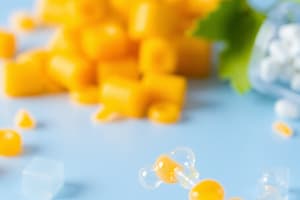Podcast
Questions and Answers
What is the main function of starch in plants?
What is the main function of starch in plants?
- Structural support
- Water filtration
- Protection against pests
- Energy storage (correct)
Which characteristic distinguishes disaccharides from monosaccharides?
Which characteristic distinguishes disaccharides from monosaccharides?
- Sweet taste
- Composition of two sugar units (correct)
- Greater solubility in water
- Presence of branched chains
Where is glycogen primarily stored in animals?
Where is glycogen primarily stored in animals?
- Skin and muscles
- Heart and kidneys
- Brain and lungs
- Liver and muscles (correct)
Which type of carbohydrate is primarily used for structural support in plants?
Which type of carbohydrate is primarily used for structural support in plants?
Which of the following statements about cellulose is true?
Which of the following statements about cellulose is true?
What is one of the key features of the structure of amylopectin?
What is one of the key features of the structure of amylopectin?
Which of the following compounds is formed through a condensation reaction?
Which of the following compounds is formed through a condensation reaction?
Which carbohydrate is primarily found in root vegetables and grains?
Which carbohydrate is primarily found in root vegetables and grains?
Flashcards
Monosaccharides
Monosaccharides
Simple sugars (single sugar unit).
Disaccharides
Disaccharides
Two monosaccharides joined together in a condensation reaction.
Starch (structure)
Starch (structure)
A polymer of glucose units; both linear (amylose) and branched (amylopectin).
Starch (function)
Starch (function)
Signup and view all the flashcards
Glycogen (structure)
Glycogen (structure)
Signup and view all the flashcards
Glycogen (function)
Glycogen (function)
Signup and view all the flashcards
Cellulose (structure)
Cellulose (structure)
Signup and view all the flashcards
Cellulose (function)
Cellulose (function)
Signup and view all the flashcards
Study Notes
Functions of Starch in Plants
- Starch is the primary energy storage carbohydrate in plants.
- It is synthesized from glucose and stored in large granules within plant cells.
- Starch is broken down into glucose when the plant needs energy.
### Disaccharides vs. Monosaccharides
- Disaccharides are composed of two monosaccharide units.
- Monosaccharides are the simplest sugars and cannot be broken down into simpler sugars by hydrolysis.
Glycogen Storage
- Glycogen is the primary storage carbohydrate in animals.
- It is primarily stored in the liver and muscle cells.
- Glycogen is broken down into glucose when the body needs energy.
Cellulose: Structural Support in Plants
- Cellulose provides structural support in plants.
- Cellulose is a polysaccharide composed of long, straight chains of glucose molecules.
- These chains are linked together by hydrogen bonds, forming strong fibers that give plants their rigidity.
Cellulose: Key Features
- Cellulose is a major component of plant cell walls.
- It is not digestible by humans but can be broken down by certain bacteria.
- Cellulose is the most abundant organic polymer on Earth.
Amylopectin Structure
- Amylopectin is a branched-chain polysaccharide.
- The branching provides a larger surface area for enzyme action, allowing for rapid breakdown into glucose.
Condensation Reactions
- Condensation reactions involve the formation of a larger molecule from smaller molecules with the removal of water.
- Carbohydrates are formed through condensation reactions between monosaccharide monomers.
Root Vegetables and Grains: Starch
- Starch is the primary carbohydrate found in root vegetables like potatoes and carrots.
- Starch is also abundant in grains like rice, wheat, and corn.
- Starch is a source of energy for humans and many animals.
Studying That Suits You
Use AI to generate personalized quizzes and flashcards to suit your learning preferences.
Related Documents
Description
This quiz explores the different types of carbohydrates, including monosaccharides, disaccharides, and polysaccharides. It covers their structural properties and functional roles in living organisms, including energy storage and structural support. Test your knowledge on key examples and their characteristics.




